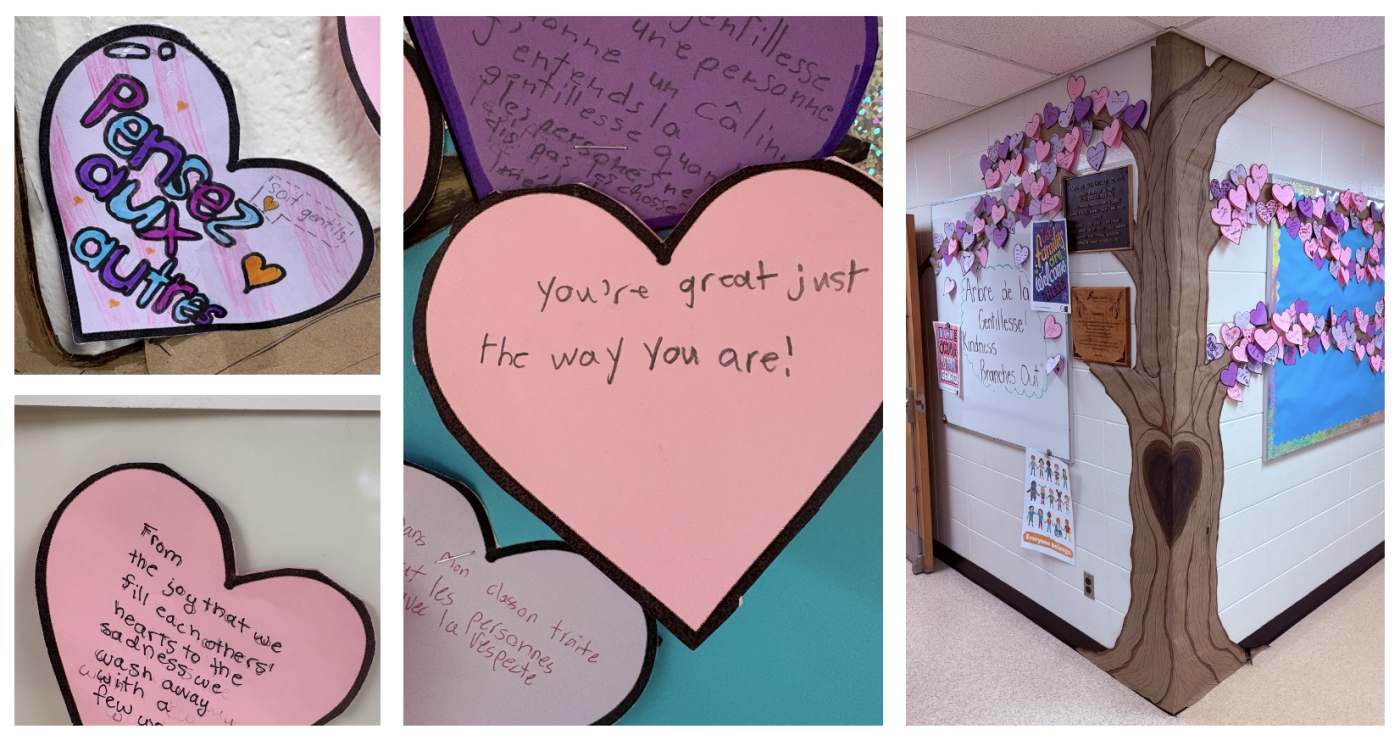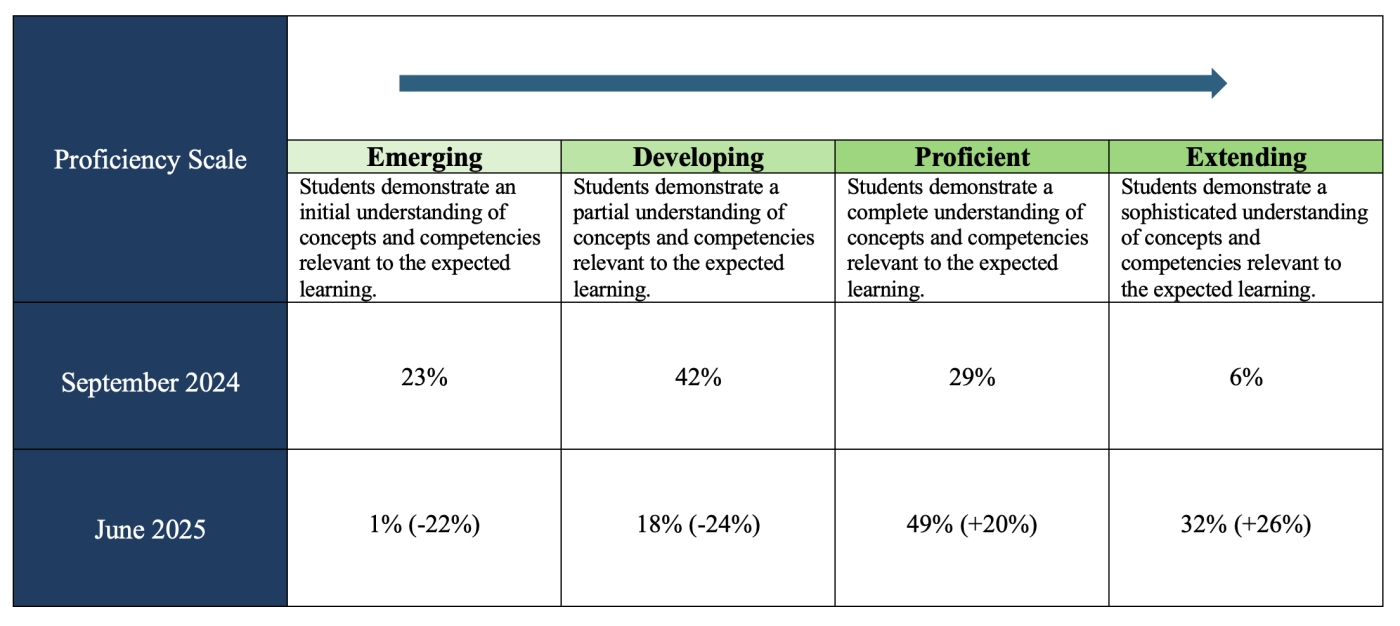École Laronde 24-25


OUR CONTEXT
OUR LEARNERS
École Laronde is home to 467 students enrolled in our single-track French Immersion program. We are proud of our students and their hard work, and we are especially proud of our diverse school community, with learners joining us from many different cultural and linguistic backgrounds. At École Laronde, we encourage students to "vivre en français" learning and living in French each day. Learning a second language strengthens thinking skills, boosts confidence, and opens doors to future opportunities, both in school and beyond. Together, we create a supportive and enriching environment where all students can thrive and grow.
At the beginning of the school year, our teaching staff gathered to reflect on the needs of our learners, and we agreed that we want to continue focusing on literacy. We also discussed the need to explore and dive into Social Emotional Learning to help our students with their self-regulation skills was equally important. We shifted our focus to include SEL alongside literacy as a proactive step towards creating a nurturing and supportive learning environment that promotes the holistic development for all our students.
Social Emotional Learning (SEL) is the process through which all children learn the skills and attitudes to develop healthy identities, manage emotions, achieve personal and collective goals, build empathy towards others, make responsible and caring decisions, and to establish and maintain healthy relationships. SEL skills allow students to engage successfully with learning opportunities that foster communication and collaboration across all curriculum areas. Social Emotional Learning is embedded in all areas of the curriculum based on the CASEL Framework.
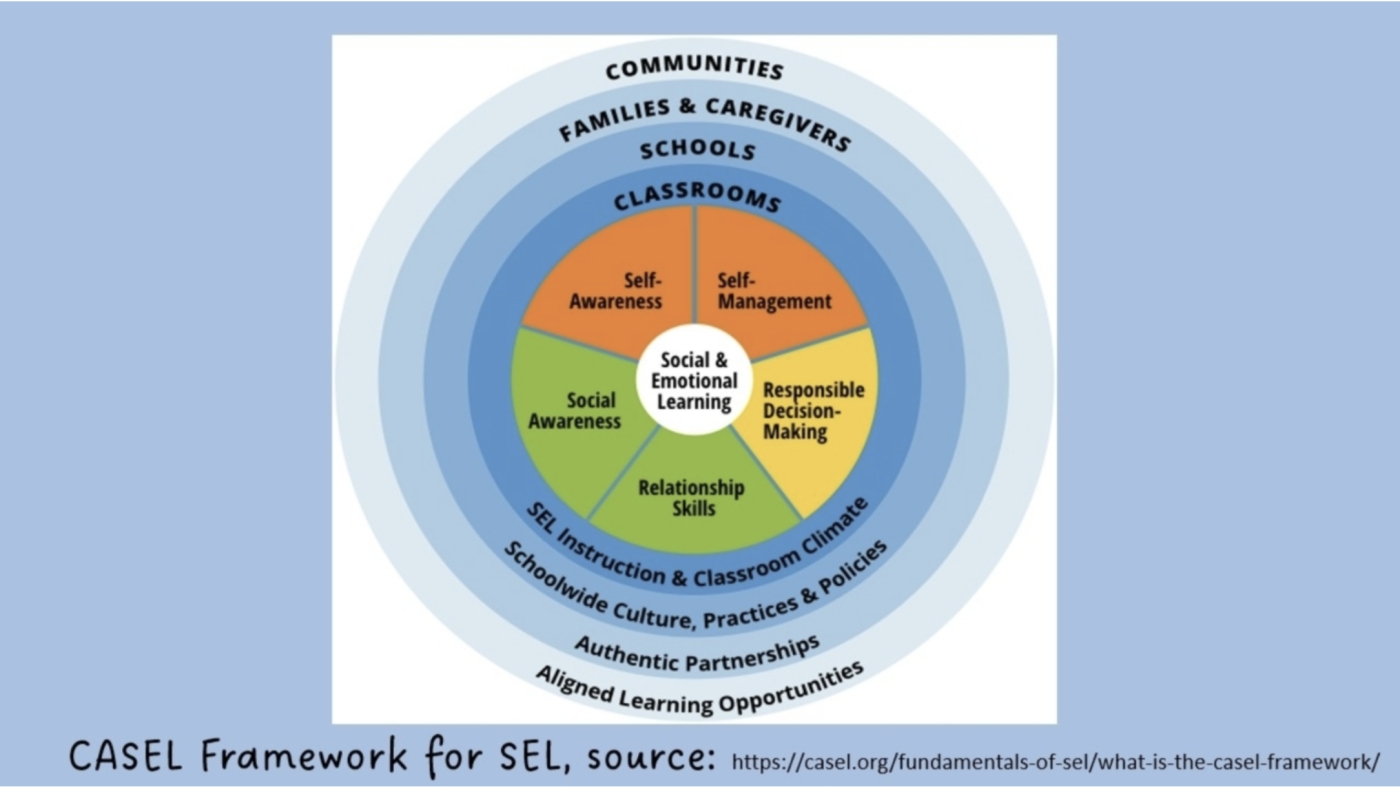
At École Laronde, we strive to meet each learner where they're at with their emotional intelligence by engaging in activities that utilize teamwork, to help build collaboration, and a sense of community so learners feel safe taking risks in their learning. By emphasizing the development of SEL, it enhances each students’ mental health, which will result in improved overall wellbeing, emotional and physical health, and academic achievement.
Literacy Connections & Social Emotional Learning
Reading & Writing
Our students engaged in stories shared in class that contained themes within the SEL Framework. With this explicit exposure, dialogue and discussions were created to further develop our students’ understanding of the various components of SEL and the widespread impact they can have.
Our learners use personal experience and knowledge to connect to text and deepen understanding of self, community, and world. They can recognize and identify the role of personal, social, and cultural contexts, values, and perspectives in texts. They can question what we hear, read, and view contributes to our ability to be educated and engaged citizens.
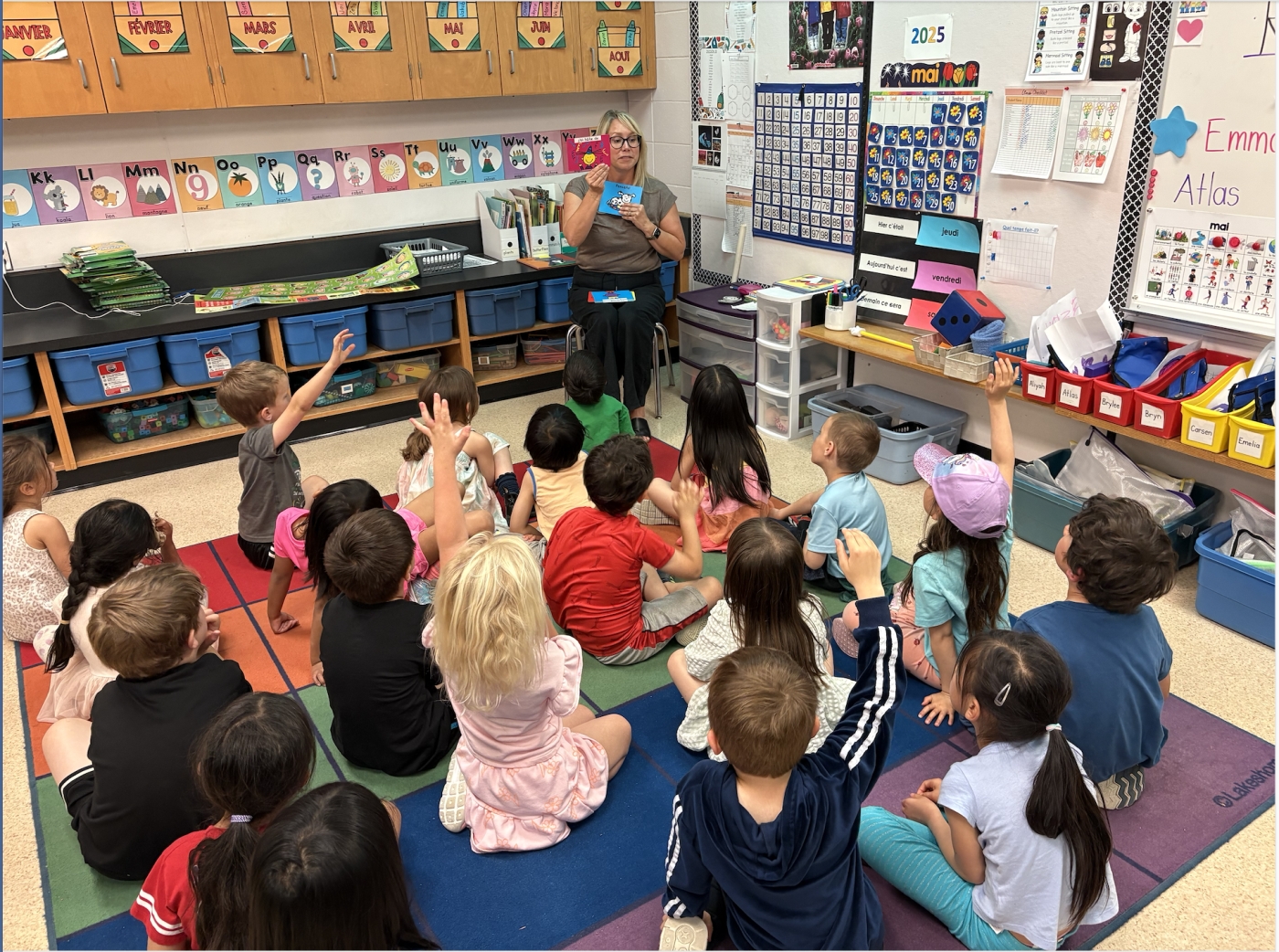
School Wide Read Aloud
Our students from Kindergarten to Grade 7 took part in a special school-wide read-aloud of Ta Voix Compte by Peter H. Reynolds which was featured at our “Shades of Kindness” assembly. Together, we celebrated our wonderful readers and the power of speaking up with kindness, courage, and purpose to share ideas, stand for what's right, and lift each other up. It was a powerful reminder that every voice, no matter how small, can make a difference.
Reading Under the Stars
This engaging event hosted by our school librarian invited students to experience the magic of reading in a cozy, starry setting. By bringing their favorite books, blankets, and flashlights, students were encouraged to immerse themselves in stories and develop a love for reading in a fun and relaxing environment. This activity supports literacy development, promotes independent reading habits, and helps create a positive and inspiring reading culture within the school.
Our learners will think critically, creatively, and reflectively to explore ideas within, between, and beyond texts. They will recognize and appreciate how different features, forms, and genres of texts reflect various purposes, audiences, and message.


I Am Enough - Read Aloud
During the "Shades of Kindness" Assembly, our Black History Month Student Committee student readers were featured in this powerful picture book, I Am Enough by Grace Byers which focuses on self-confidence and kindness.
Our learners can demonstrate respect for differences in the classroom and our school community.
"Arbre de la Gentillesse" Kindness Branches Out
The Kindness Tree displayed in the front lobby, has been beautifully decorated with heartfelt messages and artwork from students across all classes. The inspiring contributions have created a powerful visual testament to the spirit of kindness within our school community. We extend our sincere gratitude to all students and staff who participated in this meaningful project. The Kindness Tree has successfully fostered a sense of connection and positivity throughout Laronde.
Our learners can collaborate with their peers to explore what it means to show love and appreciation for themselves and others.
French Immersion - "Vivre en Français"!
Laronde is a single-track French Immersion school, which means students are fully immersed in French throughout the day. This full immersion helps them develop strong language skills quickly while also deepening their understanding of French culture and community. French Immersion supports social and emotional learning by building confidence, empathy, and cultural awareness.
Our learners can identify cultural elements in texts and compare them with one’s own cultural points of reference. They can recognize that there is linguistic variety within the Francophonie and can express themselves in French.
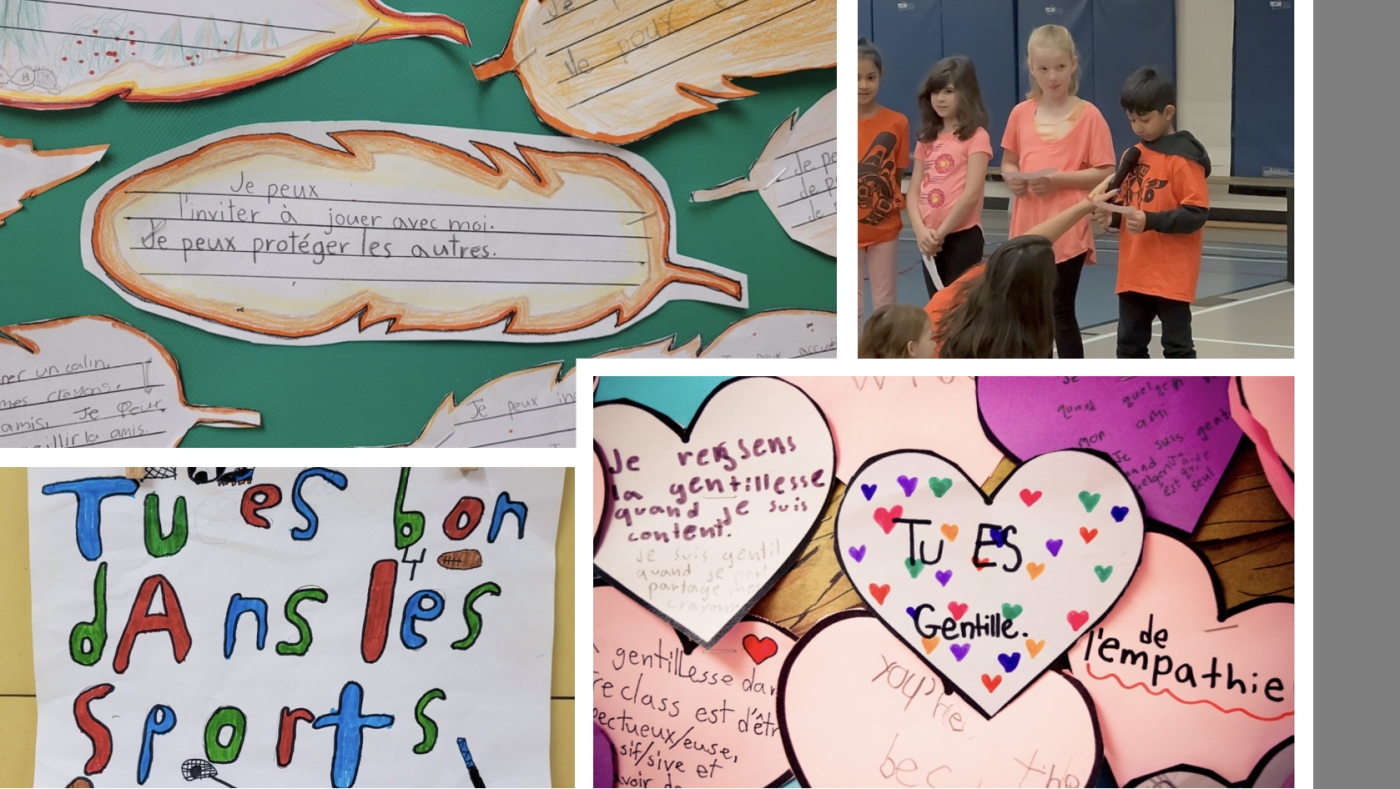
"Je me sens fier quand je comprends et parle une autre langue". I feel proud when I understand and speak another language. - Grade 6 student
Connecting SEL to Outdoor Education
We seek innovative and inclusive instructional practices to increase literacy through outside education. Outdoor education provides opportunities to grow SEL tools by nurturing connections to self, community, and natural spaces. Outdoor learning engages the senses and promotes better self-regulation. At École Laronde, students are given many opportunities to learn outside through various field trips and experiencing outside classrooms. Some of the field trips were visiting Cresent Beach, Totest Aleng: Indigenous Learning House, Sasamat Outdoor Centre, and Surrey Nature Centre where students explored the trees, beaches, and most importantly made a connection to the land. Students bonded with each other in a way that they are unable to do when they are in a traditional classroom.
Our learners develop connectedness, reciprocal relationships, and a sense of place through outdoor education. Learning is holistic, reflexive, reflective, experiential, and relational.

I love going on field trips and being outside with my friends - Grade 1 student
Our school values Indigenous Education
By integrating SEL into indigenous education, it can enhance the effectiveness of educational practices by honouring cultural identities, fostering positive relationships, promoting emotional well-being, and empowering students to thrive academically, socially, and culturally. By recognizing and building upon the strengths of Indigenous educational philosophies, SEL can contribute to creating supportive learning environments that nurture the whole child within Indigenous communities.
Our learners understand learning ultimately supports the well-being of the self, the family, the community, the land, the spirits, and the ancestors.

The Indigenous Medicine Wheel is a symbol that represents balance in four parts of life: physical, emotional, mental, and spiritual. Social Emotional Learning (SEL) helps students develop skills in these same areas taking care of their bodies, understanding and managing emotions, thinking clearly, and feeling connected to others and their community. Using the Medicine Wheel alongside SEL offers a holistic way to support students’ growth, helping them become healthy, balanced, and caring individuals.
Our learners can share First Peoples knowledge of the sky, local landscape, plants, and animals, deepening their understanding of how Indigenous perspectives reflect a deep connection to and respect for the natural world.

The Heart of Weaving: Building SEL Through Tradition
Weaving is a meaningful Indigenous tradition that connects people to their culture, the land, and their ancestors. Through the sharing of stories, teachings, and values, weaving helps keep traditions alive across generations. It also nurtures social-emotional learning by teaching patience, focus, and resilience. The practice encourages mindfulness, fosters a strong sense of identity and belonging, and strengthens community connections through shared experiences.
Our learners can explore mathematical concepts such as patterns, measurement, and geometry through the practice of weaving.

When I weave, it feels like I’m telling a story with string. Each piece shows who I am - Grade 3 student
Exploring & Learning through Loose Parts
Loose Parts play-based learning provides rich opportunities for children to develop key SEL competencies such as self-awareness, social awareness, relationship skills, responsible decision-making, and self-management. By engaging in open-ended play with a variety of materials, children not only exercise their creativity and problem-solving abilities but also strengthen their emotional intelligence and social skills, laying a strong foundation for their overall development and well-being.
Our learners understand learning is experiential, embedded in memory, history, and story, and takes patience and time. Using loose parts, students explore stories and other texts that help them understand themselves and make connections to others and to the world.

This is a park that is also a water park. The animals live in a really hot place so they like to go in the water all the time. It is fun to make stories - Kindergarten student
Physical Literacy: A Foundation for Lifelong Learning and SEL
At Laronde, we believe that physical literacy is a key component of every child’s development. It goes beyond physical activity it’s about helping students build the movement skills, confidence, and motivation they need to be active for life. By developing physical literacy, students learn to move safely and effectively in a variety of environments, supporting not only their physical health, but also their social, emotional, and cognitive development. At Laronde, we foster a positive, inclusive environment where students are encouraged to explore movement, take risks, and discover the joy of being active.
Our learners will develop and apply a variety of fundamental movement skills in a variety of physical activities and environments.
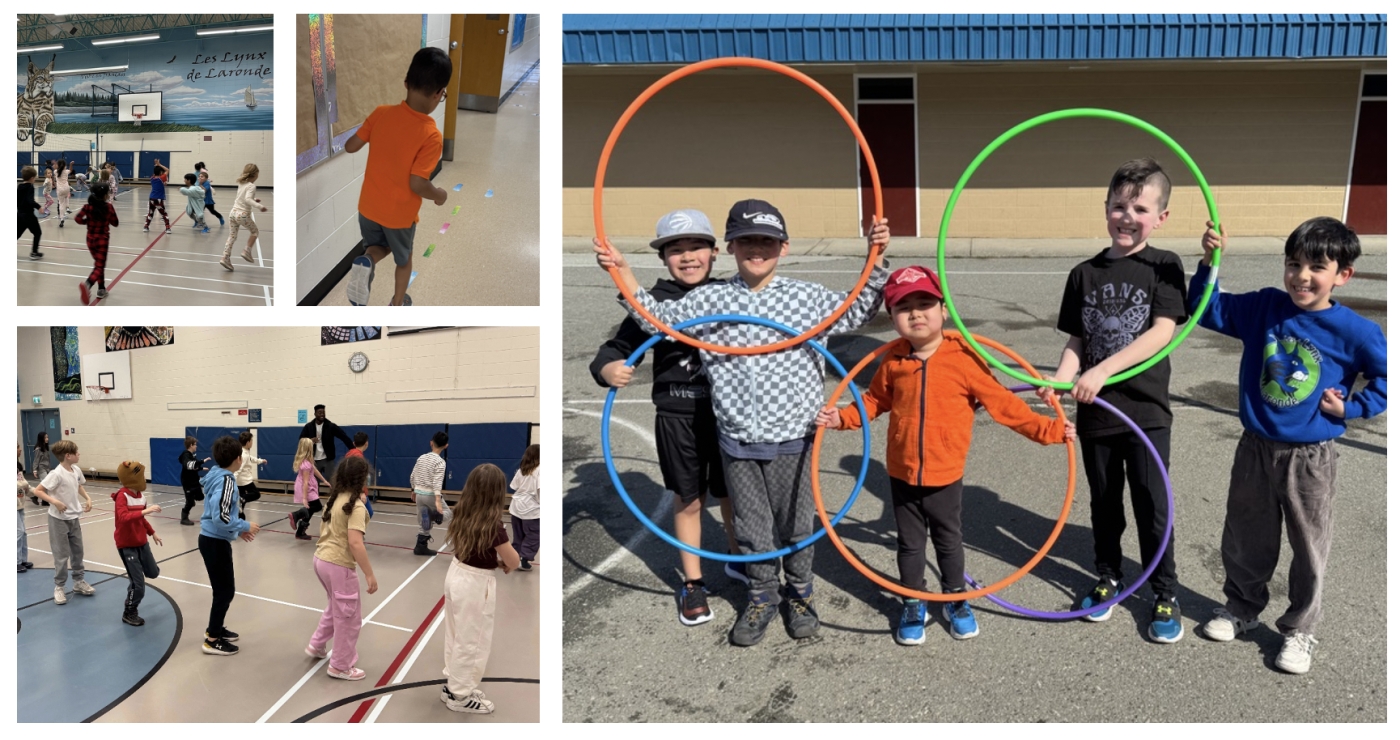
I used to be scared to dance, but now I just have fun and don’t worry what others think - Grade 5 student
OUR FOCUS
Every day, students at École Laronde are presented with opportunities to practice and demonstrate their social emotional learning skills and capabilities. Our staff is devoted to creating a culture of care in which relationships are valued and collaboration can flourish. However, a quick scan at the beginning of the year revealed that our students were finding it challenging to work and play together effectively, often as the result of difficulties with self-regulation and/or lack of appreciation of different perspectives.
We invited teachers to take a survey to gain a better understanding of their experiences with teaching and exploring Social Emotional Learning (SEL) in the classrooms at our school.
SEL Staff Survey Results

I teach Second Step and Growth Mindset throughout the year. SEL is instrumental in creating a nurturing learning environment where students can thrive academically, socially, and emotionally. - Laronde Teacher
Intervention Strategies
Skill Building Lessons
To identify students' overall strengths and areas of growth, we tracked and monitored a cohort of the three kindergarten classes. This cohort included a diverse range of learners that were representative of our school's population, but who particularly had challenges in two identified areas. The personal and social core competencies we focused on in relation to "responsible decision-making" include:
- Self-Regulating: Students take ownership of their choices and actions. They set goals, monitor progress, and understand their emotions, using that understanding to regulate actions and reactions.
- Resolving Problems: Students identify and develop an appreciation for different perspectives on issues. They show empathy, disagree respectfully, and create space for others to use their voices.
Students in our cohorts participated in various SEL themed lessons focused on our two main competency areas. These lessons were drawn directly from the Second Step program and the CASEL framework. The goal is to help students build a foundation for a positive, inclusive culture through developing social emotional competencies, which include perspective taking, empathy, processing emotions, understanding and resolving conflicts and building positive relationships.
Examples of SEL lessons include:
- Growth mindset and goal setting
- Emotion management
- Empathy and kindness
- Problem Solving
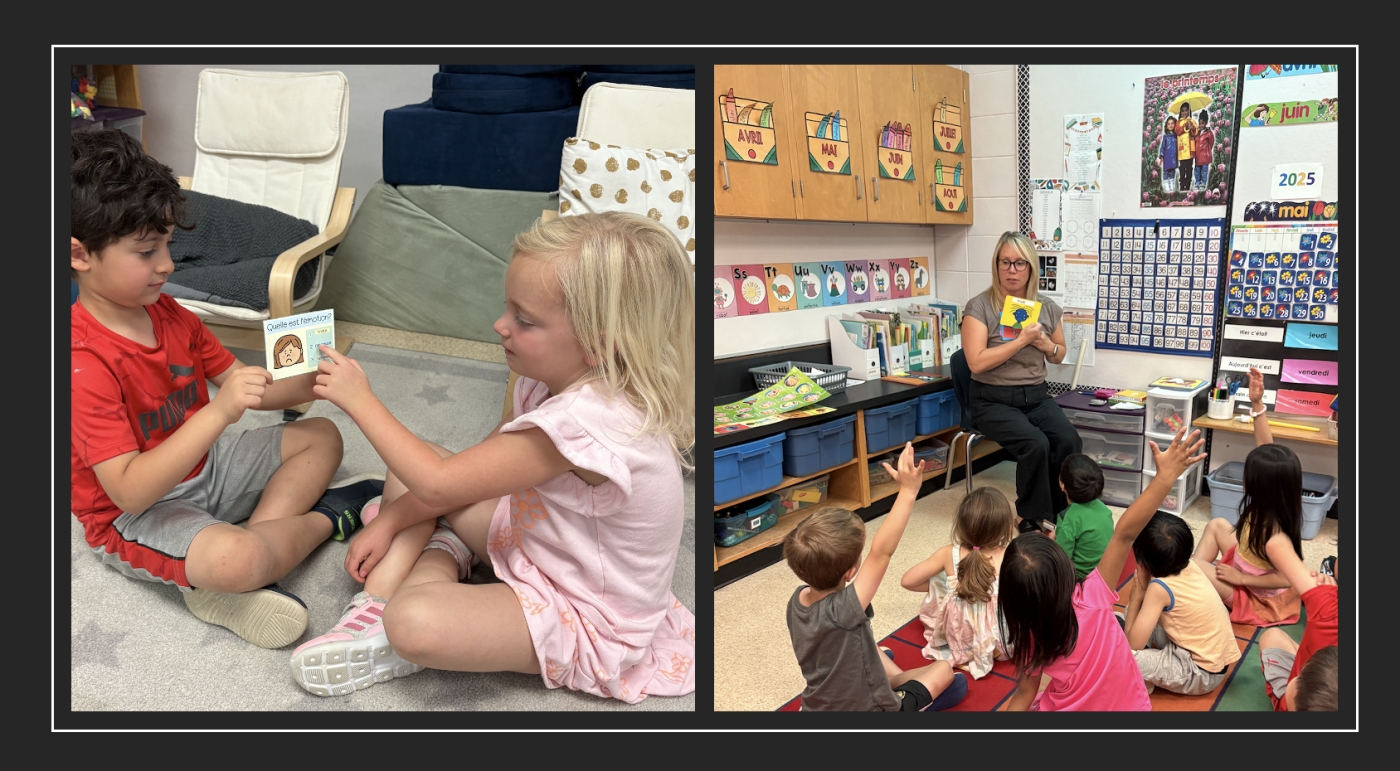
I go to the cozy corner when I need a break. It helps my body feel calm. - Kindergarten student
Other Lessons and Activities:
- Using picture books to support SEL themes like identifying and naming big emotions and solving problem peacefully.
- Providing direct instruction about and practicing positive self-talk.
- Evaluating the consequences of actions.
- Developing an understanding of the role of personal decision making in promoting community wellbeing.
"Réflexions des Petit Lynx" - Little Lynx Reflections
Integrating SEL into literacy helps students identify their feelings and grow emotionally, while becoming more confident, empathetic, and skilled readers and writers.
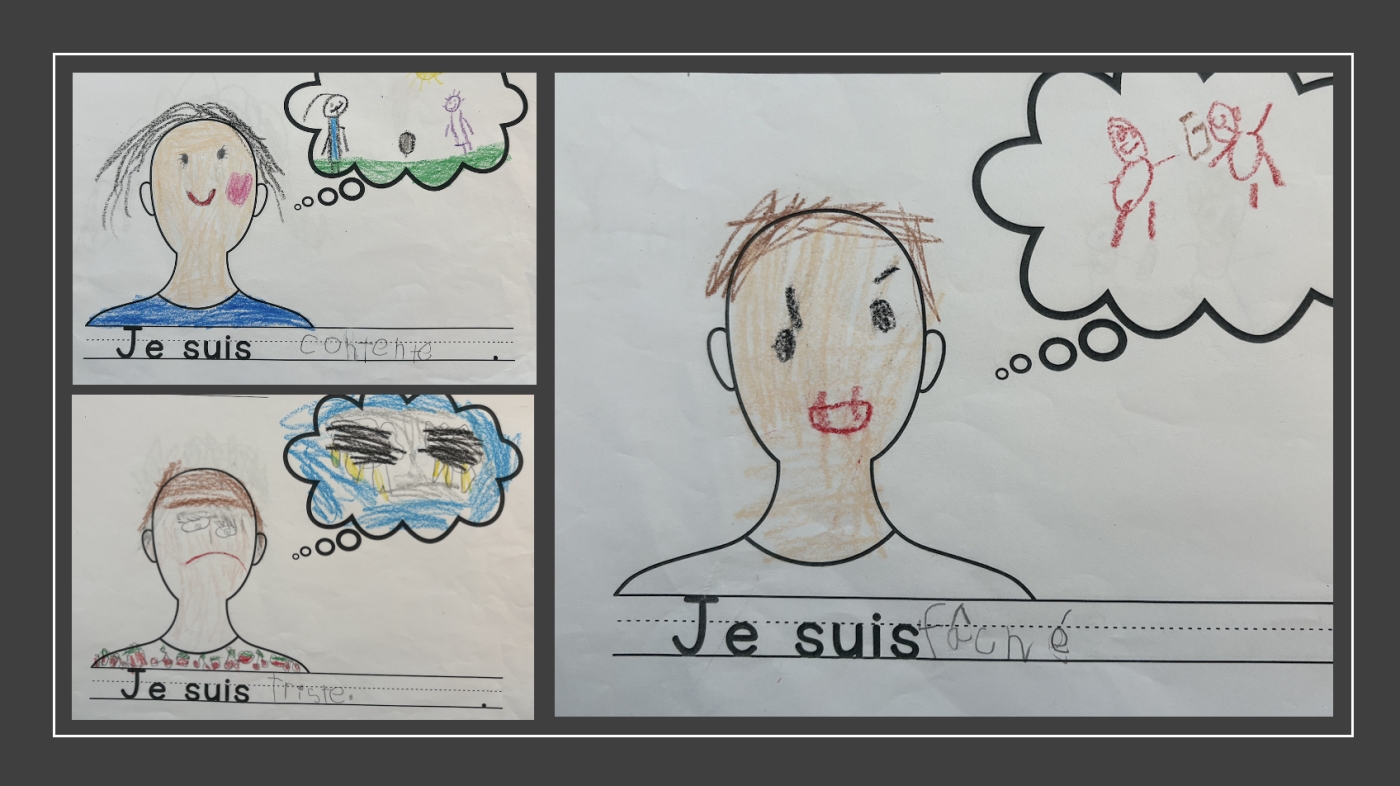
The Power of Stories and Student Voice
As part of our Literacy and SEL focus, students are encouraged to recognize, name, and express their emotions in a safe and supportive environment. One of the books we use to spark these important conversations is The Colour Monster by Anna Llenas. This engaging story helps children make sense of their feelings by connecting emotions to colours. After listening to the story, students are invited to ask questions, share personal connections, and participate in meaningful conversations about times they have felt happy, sad, angry, or confused.
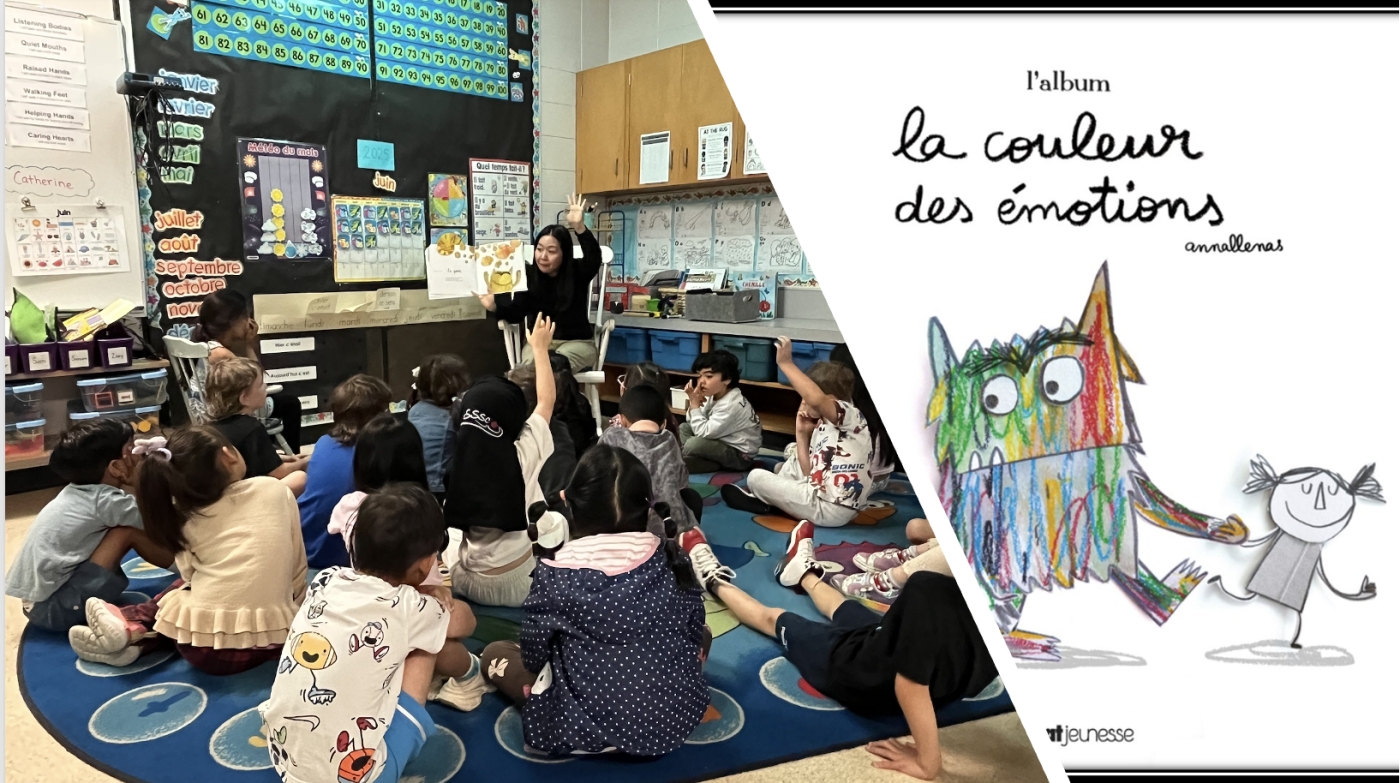
Every child’s voice matters. Through stories, we learn to understand ourselves and each other. At Laronde, our teachers believe in the power of read-alouds to spark meaningful conversations, build emotional vocabulary, and foster empathy. These shared experiences help students reflect on their feelings and develop strategies to manage strong emotions throughout the day. We encourage families to continue reading together at home it truly makes a difference.
OUR NEXT STEPS
Evidence of Growth and Areas of Focus
In September 2024, early primary teachers used the BC Ministry of Education Quick Scale: Grades K to 3 for Social Responsibility performance standards to assess students’ level of social awareness in four areas:
- Contributing to the classroom and school community
- Solving problems in peaceful ways
- Valuing diversity and defending human rights
- Exercising rights and responsibilities
In June 2025, the teachers used the same criteria scale to assess students and measure their growth over the school year. The results of the assessments below indicate a significant reduction of the number of Kindergarten students experiencing difficulty with their self-regulation and social responsibility skills.

Growth was demonstrated in the September 2024 to June 2025 social responsibility scale results. When averaging results across all four goals, we saw a decrease in the percentage of students who are Emerging (-22%) and a decrease in those who are Developing (-24%). Similarly, we saw an increase in the percentage of students who are Proficient (+20%) and students who are now Extending (+26%).
Positive Behaviour Intervention System - PBIS "Matrix"
This school year, we formed a PBIS committee to help develop and implement a school wide PBIS plan that works to promote school safety and expected positive behaviour for all of our students. The PBIS rubric we created outlines student's behaviour expectations across multiple school settings, including hallways, outside, bathrooms, etc. The goal of the PBIS rubric is to provide staff and students with clear school-wide behaviour expectations. As always, we encourage family and community involvement to support positive behaviour at school and at home. Our hope is to continue to encourage students to make safe and positive choices.

The PBIS aims to create a positive and inclusive school climate where all students can learn and thrive socially and academically by promoting positive behaviours, addressing behavioural challenges proactively, and fostering a supportive learning environment for everyone involved.
Moving Forward
Students have started to show growth based on the skills they have learned and practiced. As we continue to keep SEL at the centre of teaching and learning at École Laronde Elementary, we will continue to build on our progress by focusing on responsible decision-making. Based on evidence of students’ progress in relation to our learning goals, our next steps will be:
- to continue to take ownership of their choices and actions
- to continue to understand their emotions, using that understanding to regulate actions and reactions
- to continue to identify and develop an appreciation for different perspectives on issues
- to further explore and show empathy, disagree respectfully, and create space for others to use their voices
Students will continue to work on these areas through implicit learning opportunities embedded in the lesson designs and supported interactions between staff and students. Staff will also continue to provide explicit instruction of these SEL skills through the school-wide use of educational resources designed for SEL instruction.
As a Learning Community
- we will continue to monitor and adjust our student learning plan to meet the needs of our students
- we will continue to facilitate growth by identifying what is working and what needs to be improved
- we will explore methods to further evaluate the impact of our plan and apply this feedback to adjust ongoing teaching strategies
